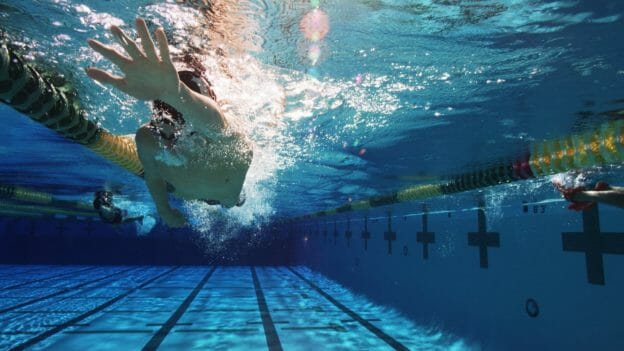In every event over the 50 meter sprint, virtually every elite distance freestyler in the world is pulling with the elbows held very close to the surface, as the hand pushes backward in the water. This motion is neither natural nor easy to accomplish, yet for any event longer than 50 meters, this is the pulling motion you need to achieve in order to swim faster.
The reason is not that this motion generates more propulsion. In fact, it probably generates less propulsion than a deeper pull. It reduces the frontal drag caused by the upper arm in the underwater pulling motion. It does so by keeping the upper arm more in line with the motion of the body during the early part of the pull. Later in the pull, when the upper arm is sticking out to the side, in a more drag-causing position, the net forward velocity of the upper arm is reduced because the upper arm is swept backward more quickly. The frontal drag caused by any part of the human body is profoundly influenced by its forward velocity.
We spend a great deal of effort at The Race Club making sure that every camper gets this motion right. Of all the techniques we teach in freestyle, we consider using the correct high-elbow pulling motion for all events over 100 meters to be the numbers 1, 2, and 3 on our priority list. In other words, you had better get it right.
These are our favorite three drills that we like to use to teach this freestyle technique. All three drills are improved by wearing fins. Snorkels are optional on the first drill, but very helpful to almost essential for the second and third drills.
- One Arm Swim. With one hand held at the side, swim freestyle with one arm only. Use one arm for the first half and the other arm for the second half of the swim. Usually we like to go no more than 50 meters, so we can make the necessary corrections. The hand of the pulling arm should enter directly in front of the shoulder, not over the head. Once the hand enters the arm is extended forward while the body rotates to the opposite side as far as possible. The opposite shoulder should be well out of the water. The hand begins its motion downward just inside the elbow, before pushing backward. The elbow should remain one inch under the surface of the water. As the hand begins to pull, the body counter-rotates toward the pulling arm to generate more coupling energy.
Swimming with one arm at a time enables the swimmer to concentrate on the precise movement of each pull. Small sculling paddles will also enhance this drill.
- High Elbow Scull. This is a more challenging drill that can also be done as a workout set. It is preferable to do it with a snorkel. The head is down and swimmer flutter kicks across the pool. The arms are held out in front, but the forearms are dropped down to an angle of about 45 degrees with the water, while the elbows point forward. Holding the upper arm still, the hand and forearm scull directly outward and directly inward with a stiff wrist and strong force, like you are playing an accordion. This motion engages the muscles surrounding the scapula in particular; the same ones that initiate the high elbow pulling motion.
Try doing a set of 20 x 25 High Elbow Sculls, kicking as fast as possible, on 30 seconds. Keep your elbows pointing forward. You will really feel the burn in the scapula muscles.
- Snap Paddle Drill. This drill is designed to help with the initiation of the correct high elbow pulling motion. Often, we see swimmers attempt the high elbow pulling motion by initiating the pull with an out sweep of the hand. This is a bad idea, as this technique will reduce propulsion and increase frontal drag. With this drill the swimmer flutter kicks with the head down and arms extended forward. The high elbow pull is initiated by pressing downward with one hand and forearm, the other held in front, while keeping both elbows near the surface. The hand always remains just inside the elbow, not outside. Instead of taking a complete pull, the motion is stopped once the hand reaches the swimmer’s chin under water and then recovers back to the front while remaining under water, similar to a dog-paddle motion. In effect the swimmer is making a small quick circle with each hand and forearm, keeping the elbows pointed forward. Once the swimmer masters this technique, we add body rotation to the same drill and motion to impress how important this coupling energy is in generating more propulsion.
To help you learn to do these drills correctly, you can subscribe to Lanes 2, 3 or 4 on our Race Club website. In the coming weeks we will feature a webisode demonstrating each of these important drills for the correct pulling motion. By subscribing, you will receive a new webisode and article from The Race Club each week.
Yours in Swimming,
Gary Sr.

